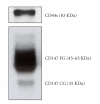Expression of monocarboxylate transporters 1, 2, and 4 in human tumours and their association with CD147 and CD44
- PMID: 20454640
- PMCID: PMC2863082
- DOI: 10.1155/2010/427694
Expression of monocarboxylate transporters 1, 2, and 4 in human tumours and their association with CD147 and CD44
Abstract
Monocarboxylate transporters (MCTs) are important cellular pH regulators in cancer cells; however, the value of MCT expression in cancer is still poorly understood. In the present study, we analysed MCT1, MCT2, and MCT4 protein expression in breast, colon, lung, and ovary neoplasms, as well as CD147 and CD44. MCT expression frequency was high and heterogeneous among the different tumours. Comparing with normal tissues, there was an increase in MCT1 and MCT4 expressions in breast carcinoma and a decrease in MCT4 plasma membrane expression in lung cancer. There were associations between CD147 and MCT1 expressions in ovarian cancer as well as between CD147 and MCT4 in both breast and lung cancers. CD44 was only associated with MCT1 plasma membrane expression in lung cancer. An important number of MCT1 positive cases are negative for both chaperones, suggesting that MCT plasma membrane expression in tumours may depend on a yet nonidentified regulatory protein.
Figures


References
-
- Gatenby RA, Gillies RJ. Why do cancers have high aerobic glycolysis? Nature Reviews Cancer. 2004;4(11):891–899. - PubMed
-
- Warburg O. On the origin of cancer cells. Science. 1956;123(3191):309–314. - PubMed
-
- Izumi H, Torigoe T, Ishiguchi H, et al. Cellular pH regulators: potentially promising molecular targets for cancer chemotherapy. Cancer Treatment Reviews. 2003;29(6):541–549. - PubMed
-
- Wahl ML, Owen JA, Burd R, et al. Regulation of intracellular pH in human melanoma: potential therapeutic implications. Molecular Cancer Therapeutics. 2002;1(8):617–628. - PubMed
MeSH terms
Substances
LinkOut - more resources
Full Text Sources
Other Literature Sources
Miscellaneous

